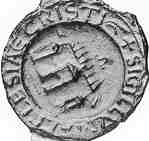
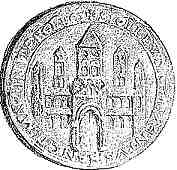
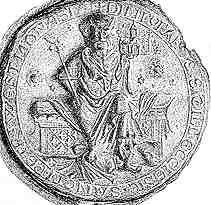
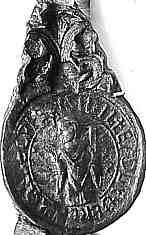
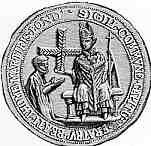
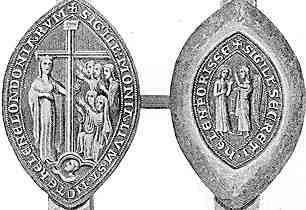
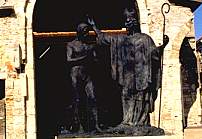
If you are looking at this page without frames, there is more information about medieval writing to be found by going to the home page (framed) or the site map (no frames).
| Seals of Ecclesiastical Institutions | |||||||||
| The church was learned and literate and conducted its business using the literate processes of the time. These required the use of a seal. Individual clerics possessed both seals of office and also personal seals, but the institutions which they served also had their own seals for ratification of documents significant to them as institutions. Possession of such a common seal became compulsory for religious houses at the beginning of the 14th century. These seals could display a diversity of designs, sometimes almost in the form of pictorial narrative. There seems to be more variety and freedom in institutional seals than in those of individuals. | |||||||||
 |
At left, the seal of Christ Church, Canterbury, from a chirograph of 1152 (British Library, Campbell Charter xxii 2). (From Warner and Ellis 1903) At right, the second seal of Battle Abbey. |
 |
|||||||
| Seals could depict the actual buildings of the religious establishment. Given that major medieval church buildings were rebuilt and modernised many times, this may give some insight into the architectural history, depending on the detail and precision of the design. Given that there is nothing left today of Battle Abbey but the late medieval gatehouse, the example above gives a tantalising hint of the abbey church building. | |||||||||
 |
The building might be included in a more elaborate composition, held symbolically by the founder or patron saint. In this example, St Peter sits enthroned and holds a model of the church in his left hand. | ||||||||
| Reverse of the second seal of Westminster Abbey. | |||||||||
| Seal of the cathedral chapter of St Halward, Oslo, from 1280 - 1320. | |||||||||
| In this seal from northern climes a bishop and seven ecclesiastics stand under the arcades of a Gothic church while Christ gives a benediction above them. It is not apparent whether this is a generic representation of a Gothic church, or a stylised depiction of St Halward's itself, as this is what it looks like today. The seal combines the image of the cathedral as a building, and as a religious community. | |||||||||
| Founders and patrons could feature in various kinds of designs. This example is unusual in that is probably represents the adoption by the abbey of the personal seal of a founder as its institutional seal. This seal is attached to a 13th century charter, but the seal matrix is believed to date from the 10th century and is the personal seal of Edith, who refounded and rebuilt the nunnery and may have been its abbess. The design features Edith with one hand raised in benediction. |
 |
||||||||
| Seal of Wilton Abbey from a 13th century charter (British Library, Harleian Charter 45 A36). By permission of the British Library. | |||||||||
 |
The Hospital of St Thomas of Acon in London was founded by the sister of Thomas Becket after his death, using the family estates to endow it. The seal shows a figure kneeling below the enthroned figure of the saint and martyr, attired in the vestments of an archbishop and holding a large cross. | ||||||||
| Seal of the Hospital of St Thomas of Acon. | |||||||||
 |
In this example, the seal depicts the story of the patron saint. St Helen, the mother of the Emperor Constantine, who supposedly discovered the True Cross; the actual cross on which Christ was crucified. Bits of it subsequently appeared as sacred relics all over Christendom. The seal shows St Helen displaying the cross to the sisters of the nunnery. She holds the three nails from the cross in her left hand. The counterseal shows a depiction of the Annunciation. It is derived from the less formal seal, labelled SIGILE SECRETI, meaning secret or privy seal. The concept of a privy seal was not restricted to the royal chancery. | ||||||||
| Seal and counterseal of St Helen's nunnery in London. | |||||||||
| At left, seal of the convent of St Gereon, Duke and Martyr, Cologne, from the 13th century; at right, sealof the Friars Minor, or Franciscans, of St Omer, of 1337. (Latter from de Boüard 1929) | |||||||||
| These two seals represent the patron saints of their establishments, the first looking very tough and ducal, bearing his palm leaf of martyrdom, and the second looking gentle and delicate, preaching to the birds according to tradition. | |||||||||
| At left, the seal of St Remi in Rheims, of 1363 (From de Boüard 1929); at right a modern statue of the baptism of Clovis on the site of the ancient ruined church. |  |
||||||||
| This seal not only depicts the patron saint of the establishment, but shows an episode from the history of the place which is considered to be sufficiently noteworthy that it is still commemorated in bronze at the site today. This is the baptism of the French king Clovis, considered to be the symbolic, if not the literally historic, conversion of the French to Christianity. | |||||||||
| Buildings, people and events real or mythological have all made contributions to the iconography of the seals of religious establishments. And the imagery does not stop there. | |||||||||
|
|
|||||||||
|
|
|||||||||
|
If you are looking at this page without frames, there is more information about medieval writing to be found by going to the home page (framed) or the site map (no frames). |
|||||||||